#Freshwater reptiles
Explore tagged Tumblr posts
Text

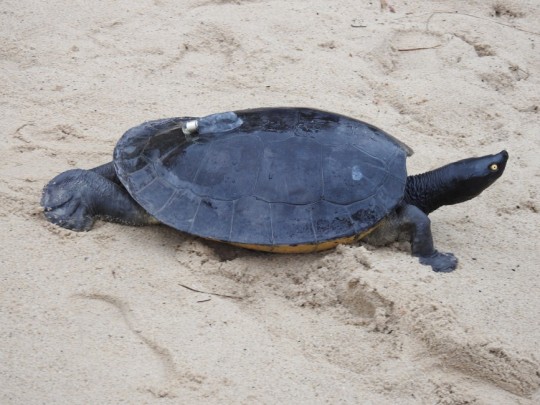

An Affinity for the Southern River Terrapin
The southern river terrapin (Batagur affinis), also known as the tungtung or the royal turtle, is a species of freshwater turtle residing, as its name implies, in the southern part of the Malaysian Peninsula, particularly along the western coast. They reside in estuaries, portions of large rivers that are regularly exposed to ocean tides.
While initially plain in appearance, the southern river terrapin can be visually striking. The body and shell are entirely black, or dark brown in females. The only spots of color are carried by males: bright yellow or white eyes and orange inner cheek flaps that are exposed when the mouth opens. Batagur affinis is also quite big, with females (the larger of the two sexes) reaching an average length of 62 cm (24 in) and a weight of 38 kg (83 lbs).
The tungtung is an omnivorous species. Its serrated beak allows it to feed on a variety of plants like grasses, algae, and fruits, as well as freshwater invertebrates like crustaceans and mollusks. Due to the high salinity of their habitats, they often leave the rivers and forage for food on land. The large size and thick shells of adults deters most predators. However, eggs and hatchlings are vulnerable to monitor lizards, otters, birds of prey, and crocodiles.
Mating for Batagur affinis occurs from October to February. Males and females remain relatively solo throughout the rest of the year, although they aren't overly territorial. Once a male locates a female, the two touch noses and he pulses his jaw to emphasize his bright orange cheek pouches and the white stripes on the inside of his throat. After copulation, the female lays a clutch of 20-40 eggs in nests dug in the sandy river bank. Young royal turtles hatch anywhere from 60-120 days later, depending on the temperature of the nest. Juveniles can take 18-22 years to reach maturity. Adults regularly reach ages well over 45, and individuals as old as 100 have been recorded.
Conservation status: The southern river turtle is considered Critically Endangered by the IUCN. Over-harvesting of both eggs and individuals has decimated populations, and those that remain are threatened by habitat destruction. However, both local and international conservation efforts have been underway to preserve the species and its ecosystem.
If you like what I do, consider buying me a ko-fi!
Photos
Eng Heng Chan
Paul Calle
Thorn Sophun
#southern river turtle#Testudines#Geoemydidae#turtles#reptiles#freshwater fauna#freshwater reptiles#rivers#river reptiles#tropical forests#tropical forest reptiles#asia#southeast asia#animal facts#biology#zoology#ecology
530 notes
·
View notes
Text
youtube
Gharial: Nature's Fish-Eating Specialist
Discover the fascinating world of the Gharial, a unique crocodilian adapted for a life in water! Learn about its diet, behavior, and habitat.
Check out my other videos here: Animal Kingdom Animal Facts Animal Education
#Helpful Tips#Wild Wow Facts#Gharial#Crocodile species#Fish-eating crocodile#Endangered species#Indian wildlife#Wildlife conservation#River habitat#Ganges River#Reptile documentary#Nature documentary#Animal facts#Rare animals#Aquatic predators#Wildlife photography#Crocodile behavior#Gharial hunting#Gharial conservation#National parks India#Reptile species#Freshwater reptiles#Animal kingdom#Wildlife enthusiasts#Nature lovers#Indian rivers#Reptile protection#youtube#animal behavior#fun animal facts
1 note
·
View note
Text
Wet Beast Wednesday: saltwater crocodile
66 million years ago, reptiles ruled the planet, being the largest, most efficient, and most dominant animals. Then a big space rock ruined that and cleared the way for the mammals to take over. Not all reptiles have forgotten their glory days and there are places where they still rule. Meet the saltwater crocodile, the largest and most dangerous reptile in the world and a reminder of their glory days.

(Image: a saltwater crocodile basking in the sun. It is a large reptile with short legs and a large, angular head with massive jaws lined with conical teeth. It has a long tail and its back and tail are lined with rows of scutes. It is a very dark green, almost black, in color. Its mouth is slightly open. End ID)
Crocodylus porosus is the largest crocodilian and largest reptile alive today. They are sexually dimorphic, with the males growing much larger than females. Most males are between 4 and 4.5 meters (13'1" to 14'9") and 408 to 770 kg (899 to 1698 lbs), but they can grow larger in optimal conditions. The largest specimen on record was found dead and estimated to be 6.3 m (20'8") while alive. The largest captive crocodile was named Lolong and weighed in at 6.17 m (20'3") and 1075 kg (2370 lbs). Females typically reach up to 3.4 m (11'2") and 200 kg (440 lbs), with the largest on record being 4.3 m (14'1"). Saltwater crocodiles have the greatest size difference between sexes of any crocodilian and it is thought that this is due to males needing to control a large territory. Saltwater crocodiles, like other crocodilians, are large, amphibious reptiles with large, long jaws and powerful tails that are used to propel them while swimming. Their bodies are covered with scales and scutes, though they have relatively few of the latter compared to other crocodiles. Their heads and bodies are broader than in most crocodiles, leading to an early misidentification of them as a species of alligator.

(Image: a close-up of the head of a saltwater crocodile, showing how high its eyes and nostrils are and its rough, scaly skin. A small leaf had landed in its snout. End ID)
Saltwater crocodiles have a wide historical distribution stretching from eastern India, north to China and Japan, and throughout the Indo-Pacific and Australasia. Overhunting has led to their range being reduced, with many isolated populations. The largest and most stable population is now in northern Australia. They occupy coastal regions and rivers, including mangrove swamps and estuaries. While other crocodile species can tolerate saltwater, only the saltwater crocodile regularly inhabits it. Their ability to tolerate saltwater has helped them get such a large range. The crocodiles can swim out to sea and let ocean currents carry them to new habitats. Tagging and observation has shown that they are powerful swimmers who can venture over 500 km out to sea, they spend most of their time in the ocean simply waiting to be carried to new feeding ground. Those traveling by ocean will occasionally return to land to warm up and wait for the currents to change. Ocean trips can last so long that barnacles can start to grow on their hides. Saltwater crocodiles spend more time in the water than any other crocodile species, but they must return to land to bask in the sun and raise their temperatures. As with other crocodilians, they often bask with their mouths open. The open mouth helps regulate their body temperature. Saltwater crocodiles are typically more active than most other species and spend a lot of their non-basking hours swimming in search of food or to patrol their territory.

(Image: a saltwater crocodile swimming underwater. Its body is skinny when viewed from the side. From this angle, its lighter underbelly is partially visible. End ID)
Saltwater crocodiles are opportunistic predators that will eat just about anything. Juveniles are restricted by their size and feed on fish, crustaceans, molluscs, birds, and small mammals. As they grow, their diet expands to larger animals such as dingos, emus, deer, boars, and primates. The larger males can take prey as large as water buffalo. Even the largest male will still take small food if the opportunity arises and they have shown some resistance to the poison of the highly invasive cane toad. As with other crocodilians, saltwater crocodiles are ambush predators. They tend to sit very still, allowing them to be mistaken for sunken logs and their eyes and nostrils are high on their heads, letting them keep most of their bodies submerged. When prey comes along, they will attack with their powerful jaws. Saltwater crocodiles have the most powerful bite force of any living animal and their teeth can be up to 13 cm (5 in) long. Prey not killed by the initial bite will be dragged into the water. Crocodiles practice the death roll, a habit of spinning themselves around while biting onto prey to dismember it. Food can be dragged underwater and stored until it starts to rot to make eating easier. Saltwater crocodiles have also been known to jump vertically out of the water to attempt to catch flying prey like birds and bats. They also also been known to use these leaps to try to knock monkeys and gibbons off of overhanging branches and into the water. While out at sea, the crocodiles will feed on marine animals as large as dugongs and sharks. Saltwater crocodiles, especially males, are highly territorial and will fight to defend their feeding grounds. Because of their slow metabolism and lethargic lifestyle, crocs can go months between meals.

(Image: a saltwater crocodile launching itself vertically out of the water to attempt to grab food that is being dangled above it. The front half of its body is sticking out of murky water and its mouth is wide open. End ID)
Saltwater crocodiles mate during the wet season, when temperatures and water levels are rising. Females will select the nesting site, which is usually a stretch of muddy shoreline. She then lays her eggs in an excavated pit and buries them under a mound of soil and vegetation that helps keep them warm. The clutch usually numbers 40 to 60 eggs, but can reach up to 90. The mother will remain near the nest until hatching, which can be over 100 days. When they young are close to hatching, they will emit yelping cried that triggers the mother to dig them out and even help hatch them by gently manipulating the eggs in her mouth. Once hatched, she will carry her young to the water and remain with them for around 8 months as they grow. Despite the protection of the mother, the eggs and juveniles are highly vulnerable to flooding and predation and only 1% of laid eggs will reach adulthood. Once they reach about 2 and a half years, the juveniles will begin to display territorial behavior and will stop associating with other members of their species. Females reach sexual maturity at around 12-14 years and males around age 16. They have a very long lifespan, with reports of crocodiles reaching ages of 70 and older. Most mature females will mate one a year and they do not show mate fidelity.

(Image: a juvenile saltwater crocodile basking on a log. It share the body shape of an adult, but its scales are a light, sandy color with dark patched. Its mouth is open. End ID)
Saltwater crocodiles are considered least concern for global extinction, but they are vulnerable to local extinction in many parts of their range. Habitat loss and poaching are major threats to them. Saltwater crocodiles are hunted for their meat, eggs, and skin, and poaching in a problem in large parts of their range. The most stable population exists in northern Australia due in part to conservation efforts and populations of feral goats, pigs, and buffalo that serve as a plentiful food source. Saltwater crocodiles are one of the few crocodiles that will eat humans. In fact, they are the species most likely to treat humans as prey. Their size and ambush tactics make them highly dangerous when attacking and they are likely to treat people entering their territory as threats. Males are more likely to be dangerous than females. Relocating problem crocodiles is generally ineffective s they or another crocodile usually find they way back to the now empty territory. The best way to avoid attacks is to stay out of their territory. In Australia, warning signs around crocodile habitat have been shown to be effective at reducing attacks. There are an average of 2 fatalities a year in Australia and attacks in other countries usually go under reported. Negative public opinion of the crocodiles has hampered conservation efforts as they are often attacked in revenge killings.

(Image: a saltwater crocodile basking with a radio tag attached to its back, the antenna sticking up. In the background is famous animal conservationist Steve Erwin, laying down in the water and looking toward the camera. End ID0
#wet beast wednesday#saltwater crocodile#crocodile#crocodilian#reptile#reptiles#aquatic#freshwater#saltwater#estuary#australia#biology#zoology#ecology#herpetology#nature#animal facts#informative#educational#image described
73 notes
·
View notes
Text


106 notes
·
View notes
Note
Can you do a Mata Mata? Or any turtle really :)
Who could pass up a chance to share the mata mata!! Magnificent choice.
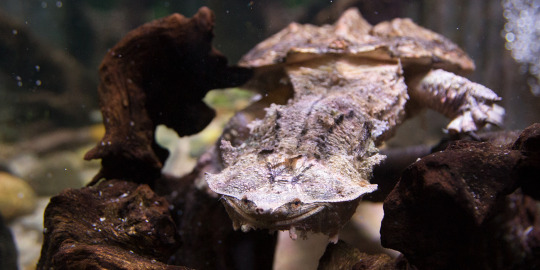
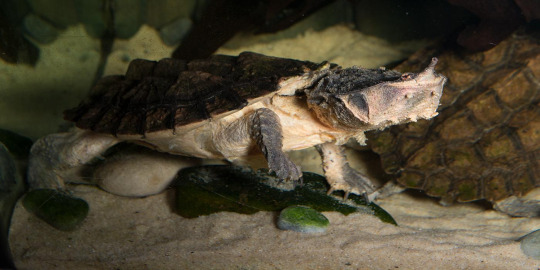
Both photos thanks to the Smithsonian's Reptile Discovery Center.
#south american wildlife#mata mata#matamata#mata-mata#freshwater turtle#turtle#reptilia#testudines#pleurodira#chelidae#animal polls#poll blog#my polls#animals#polls#tumblr polls#reptile#herpblr
46 notes
·
View notes
Text
Macquarie short neck turtles
8 notes
·
View notes
Photo
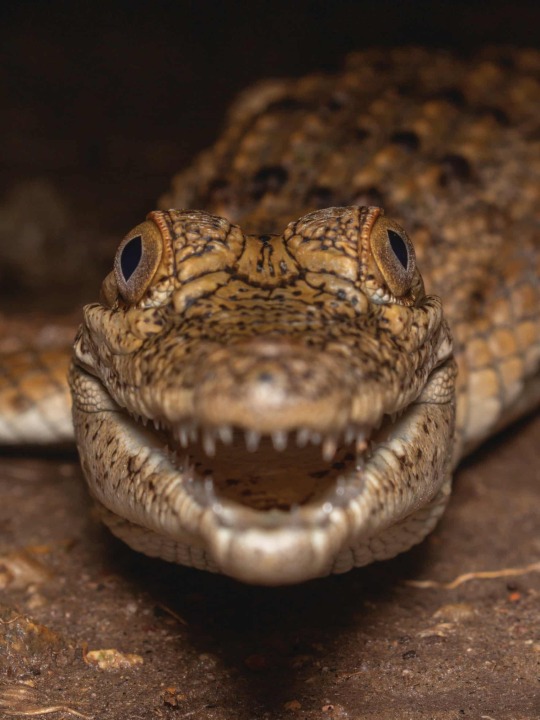
Freshwater crocodile. Location: Townsville, Queensland.
Photograph: Elliott Budd
#elliott budd#photographer#freshwater crocodile#crocodile#reptile#townsville#queensland#australia#nature
122 notes
·
View notes
Text
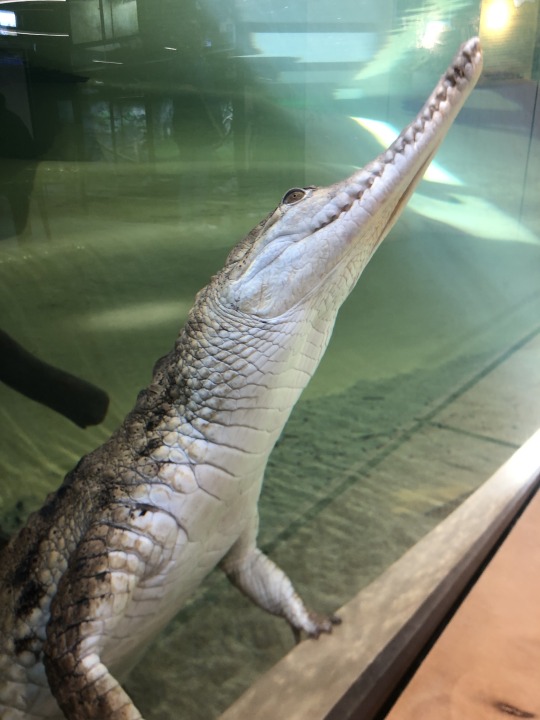

look at this Funky crocodile ft. This turtle who is looking very intently
#I think her name is Cleo? We have two crocodiles and I can’t tell them apart lol#reptiblr#reptile#crocodile#turtle#freshwater crocodile#long-necked turtle#reptile wednesday#lizard
63 notes
·
View notes
Text
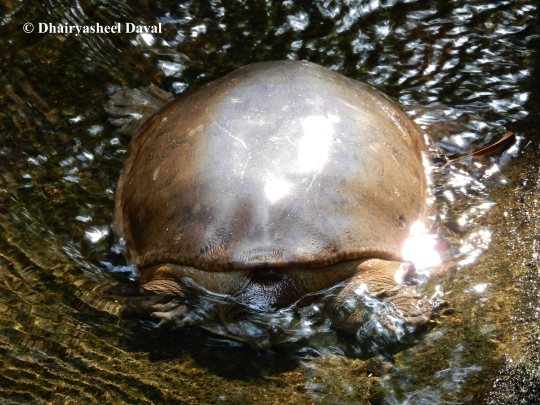


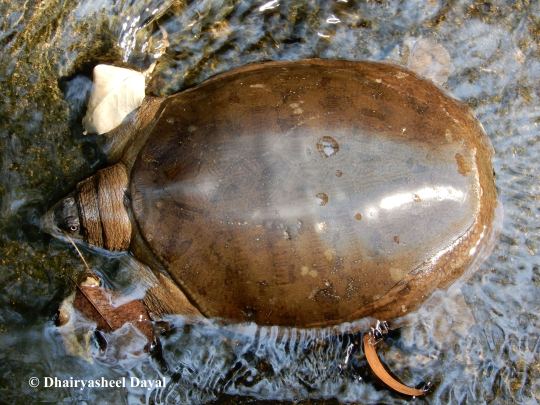

The Indian flapshell turtle (Lissemys punctata).
Conservation Status: VULNERABLE.
#indian flapshell turtle#flapshell turtle#turtle#turtles#reptile#reptiles#freshwater turtle#freshwater species#freshwater animal#freshwater#aquatic#aquatic wildlife#wildlife#wildlife of india#wildlife photography#turtles of maharashtra#turtles of india#indian wildlife#shells#shell#vulnerable#vulnerable species
5 notes
·
View notes
Photo
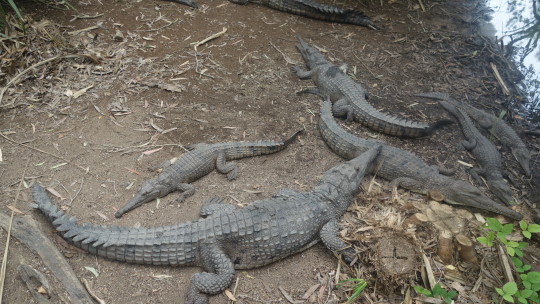
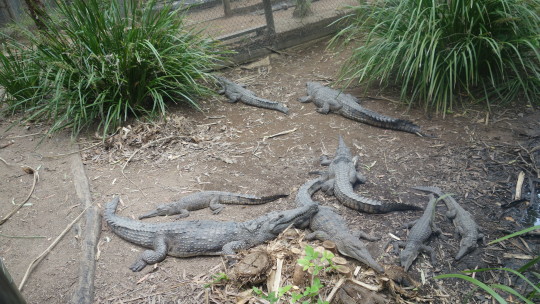
Freshwater crocodiles at Billabong Sanctuary near Townsville, QLD, Australia
9 notes
·
View notes
Photo
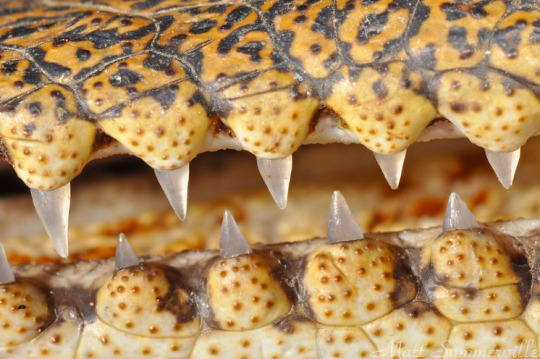
The teeth of a freshwater crocodile (Crocodylus johnstoni). Kununurra, Western Australia.
Photo by Matt Summerville [x]
4 notes
·
View notes
Text


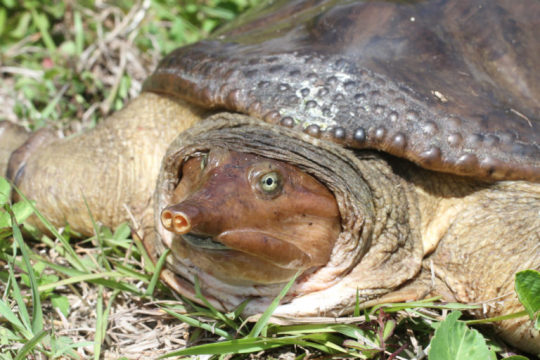
Feeling Out the Florida Softshell Turtle
The Florida softshell turtle (Apalone ferox) is a species of softshell turtle that resides only in the southeastern tropics of the United States, especially along the Atlantic Coast and the Gulf of Mexico. Within this range, they can be found in a number of freshwater environments, including ponds, lakes, swamps, marshes, and urban catchments; they may occasionally also occur in the mouths of slower moving rivers and streams. They generally prefer more muddy bottoms, in which they can bury themselvesand forage for food.
Florida softshell turtles have a highly varied diet, obtained through both active predation and scavenging. When hunting, they may bury themselves at the muddy lake bottom and wait for potential prey to come close enough for an ambush. They are largely carnivorous, feeding on fish, insects, crustaceans, frogs and mollusks, as well as the occasional aquatic plant. Adults are primary predated upon by alligators, while juveniles and eggs may fall prey to foxes, raccoons, birds, and large fish.
Although A. ferox is almost entirely aquatic, adults will readily move overland to find more suitable habitat. They are also frequently spotted basking on rocks or logs. Adults are highly aggressive, and will attack anything they percieve as a threat, including birds, fish, other turtles, and people. In addition to their ferocious bite, they also emit a foul-smelling musk to drive away potential predators.
Mating for the Florida softshell turtle occurs once a year, in the spring from March to July. After mating, females lay their eggs along river or lake banks in clutches of 9-24 eggs. Although they only mate once, females may lay anywhere from 2-7 clutches in a single year. Each clutch incubates for 56 to 80 days, and are immediately independent. Males reach maturity at only 2 years old, while females take 5-8 years; both sexes may live to be over 20 years old in the wild.
Although perhaps not the most attractive turtle, the A. ferox has a very striking appearance. They have a large, flattened body which is covered-- limbs and shell both-- in leathery, olive green or brown skin, with a lighter underside. The shell may also sport darker spots, which help the individual blend in to the muddy substrate. The head is specially distinctive, with a long neck and flattened skull, terminating in a pointed, tubular nose. Individuals may use their extended nostrils to breathe without exposing their body above water. Female Florida softshell turtles are much larger than males; 40.1 cm (15.8 in) in length and 6.65 kg (14.7 lb) compared to only 35 cm (14 in) and 2.68 kg (5.9 lb).
Conservation status: The Florida softshell turtle is considered Least Concern by the IUCN. However, they are threatened by harvesting for meat and the pet trade, as well as habitat loss.
If you like what I do, consider buying me a ko-fi!
Photos
Andrea Westmoreland
Paul Cools
J.D. Willson
#florida softshell turtle#Testudines#If you like what I do#consider buying me a ko-fi!#softshell turtles#turtles#reptiles#freshwater fauna#freshwater reptiles#wetlands#wetland reptiles#lakes#lake reptiles#north america#southern north america
93 notes
·
View notes
Text
The large compound island of New Guinea, and adjacent, tropical areas of Australia, are home to a remarkable turtle species, that is an outlier in at least four ways - its lack of close living relatives, its location, and its locomotion. This is the pig nosed or Fly River softshell turtle, also known as the pitted shell turtle, and Carettochelys insculpta. This curious freshwater turtle is now a common zoo exhibit, and occurs in the pet trade especially as cute juveniles, although it's size and cruising habit, make it problematic as a pet turtle. Fortunately care of C. insculpta is very well understood, and not problematic other than their requirement for living space.
C. insculpta is the only living Catettochelys species that is recognized. Very large individuals of this species reportedly have a carapace length of nearly 60 centimeters, or 24 inches. Yet more commonly they are around 25 centimeters, or 14 inches. In New Guinea this species is found only in the southern lowlands of the island, whereas in Australia it is found in Northern Territory. The exact distribution of C. insculpta is uncertain as regards both New Guinea and Australia, but the species is limited to the tropics.
The size of T. insculpta varies by geographical origin, with those from the Kikori area weighing 10 kilograms more than those from the Daly River. In spite of this, no morphological evidence has been presented to justify supposed subspecies distinctions. The great similarity between New Guinea and Northern Territory Carettochelys turtles, and their limited Australian distribution, indicate they dispersed to Australia from New Guinea at some time during the Quarternary.
Carettochelys are found in rivers and streams with soft bottoms and slow currents. Such habitats are rich in leaf litter and wood debris. They are also present in still water bodies in New Guinea. Hatchling Carettochelys can be found in New Guinea river deltas, but as adults they are migrated upstream. Australian populations do not frequent estuaries at all, and are thus more strictly freshwater. These Australian Catettochelys have more habitat available in the wet season, when they are able to move into nearby creeks, and exploit flooded floodplain environments.
Oftentimes people object that Caretrochelys are not true softshells, on the grounds that they are not members of the trionychid clade, that is named for Trionyx, an African softshell turtle. But Catettochelys is their definite sister, and together with the trionychids, they comprise the clade Trionychia. The first trionychians were already softshells, and the morphological status as softshell is inherited by both Carettochelys and its trionychid sisters.
The presence of a northern type turtle, like Catettochelys, in the Australasian realm is a bit of an enigma. Although there are no longer native carettochelyids in the northern hemisphere today, ancestral carettochelyids during the Eocene epoch, appear to have exclusively inhabited northern continents. Therefore ancestral Catettochelys must have reached island Australasia prior to their extinction in Asia. It is not known when carettochelyids arrived in Australasia, and there is currently only one species.
Some other New Guinea turtles, that are members of the trionychid group, are also of Asian affinities. All other Quarternary turtles in New Guinea and Australia, are either pleurodires or meiolaniids. Both these clades are descended from ancestors that were present since the breakup of Gondwana in the Cretaceous and Early Palaeogene. Northern type turtles in Australasia are much more recent arrivals in Australasia, and they are limited to the northern continental mainlands.
Australia has a well deserved reputation for her unique animal life, having evolved in isolation from those of their inhabited continents. However her isolation has not been total, and as she has been carried north towards Asia by forces below the earth's shallow crust, new kinds of animals have arrived on her shores from Asia, including murid rodents, and agamid and varanid lizards.
Although the biota and ecology of Australasia is distinct from that of Asia today, there is overlap between the animal and plant life of these continents, despite the lack of land connections between the continental masses of 'Sundaland' and 'Sahulland'. In fact the climate is an effective barrier, with drier and more season climates in eastern Indonesia, working with the sea to separate the rainforests on the Sunda shelf from those on New Guinea.
Climate zones within Australia largely limit New Guinean faunal and floral components, which include more Asiatic elements than those of Australia, to the north of Australia. The fauna and flora of which, cannot easily be demarcated apart from those of southern New Guinea. Indeed two land bridges across the present Torres Strait, had connected the island continents during the Pleistocene, during which time the sea levels were lower, allowing migration between what are now discontinuous land masses.
Although Catettochelys is unrelated to Holocene sea turtles, it swims with an unusual motion intermediate between the fore and aft rowing of typical, plesiopodal freshwater turtles, such as the red eared slider, and hydropodal sea turtles that swim by employing vertical strokes, or underwater flight. Like the sea turtles, Catettochelys makes more use of its deltoideus muscle in its swimming stroke, creating better forces of lift that facilitate pelagic abilities.
These turtles are quite catholic omnivores, consuming both plant and animal food resources, but their feeding habits become increasingly vegetarian as they mature. They feed extensively on tropical fruits such as Ficus, Sonneratia, and Nypa, that fall into the water where Carettochelys feed, and they also consume a broader diversity of waterside and aquatic plant material, such as the eelgrass Valisneria and algae.
Their aquarium diet should therefore include algae wafers and fresh fruits and vegetables, such as banana, melon, and lettuce. Dried preparations can be fed to these turtles, but it is much preferable to choose those with a rather low protein content. Usually they prefer to eat at the bottom so sinking pellets are a better choice than floating sticks. They will also readily eat defrosted and fresh meaty items. Respecting their omnivory, their diet should be varied and its vegetable component should make up about 2/3 of the diet of adult Carettochelys.
The animal prey that are consumed by Carettochelys are benthic and slow moving, including snails and crayfishes. Therefore these turtles are not suited for sharing an environment with hard shelled potential prey. They are also likely also to consume some aquarium plants. Vertebrates are said only to be eaten as carrion, but opportunistic predation on small, slow or sleeping fish cannot be excluded, because this is normal benthivorous turtle behavior.
Although they are active and efficient midwater swimmers, Carettochelys are foragers and not hunters. Fishes that are significantly larger than their heads will be safe. This species is also peaceable towards other turtles, and is often housed in zoos alongside Australasian pleurodires, of the genera Chelodina, Elseya, and Emydura. Indeed Catettochelys is by now a very popular species in mixed species exhibits, having a good tolerance of other animals, and being much easier to accommodate than are marine turtles.
Im spite of this overall good tolerance, Carettochelys males can actually be aggressive to one another, and in horny condition can harass females with tail biting behavior. Rarely males can be aggressive towards other turtle species, and even fish sharing their environment, but this is a statistical tail end effect, and cannot be considered typical. Usually it is sufficient not to cohabit two males together.
The morphology of the Catettochelys humerus is most similar to that of the trionychids, yet it's shape is convergent upon that of sea turtles. Overall the forelimbs are more efficient hydrofoils than is normal for a freshwater turtle, although they still walk and swim using an alternate coordination of all four limbs, despite being well capable of a graceful, penguin-like underwater flight using the forelimbs alone.
Compared to the trionychid sister clade, Catettochelys possesses elongated autopodia, making the forelimb a functioning underwater 'wing'. This elongation is already described in the extinct, northern hemisphere carettochelyids, but it is thought to be unique among all of the non-marine turtles. The swimming style of Carettochelys gives it an advantage when competing against pleurodire turtles, because it is useful for finding food in low energy environments. The mystery is why no turtles swim like this today, in the tropical rivers of the Congo, Amazonia, or Southeast Asia.
Catettochelys even possesses salt glands, but they are degenerated, like those of the gharial Gavialis, a riverine crocodilian descended from marine ancestors. However it is not resident in brackish environments as an adult, and should be regarded as a truly freshwater turtle. This species visits estuaries only to nest on sandbanks, before returning upstream as they grow. Some Carettochelys juveniles reside in brackish water with salinities up to 21 ppt, or a specific gravity of 1.015.
Often animals and plants that outlive their relatives, in the sense of the geological timescale, have shifted to novel environments. Like the gharial, and the South Asian, Chinese, and Amazon river 'dolphins', of middle Cenozoic origins, Carettochelys appears to represent the phenomenon of atypical, freshwater subclades surviving longer that their marine cousins.
Depending on the location and the time of the year, Carettochelys in the wild may experience an approximate spectrum of pH from 6.5 to 8.5, although the average pH in the river channels is surely 7 to 8. During the wet months, when Catettochelys make use of flooding to access the floodplain, the water pH is lower, despite the strange but widely circulated claim online, that Catettochelys requires hard, alkaline water parameters.
The water temperature in river channel environments is in the middle and upper 20s degrees centigrade. In floodplain habitats the temperature may seasonally reach the upper 30s. If they are maintained at brackish salinities, which is not necessary, the specific gravity should not reach 1.02, and they will still need to drink freshwater, as do marine snakes and birds with functioning salt glands, that still drink rainwater.
#Carettochelys insculpta#pig nosed softshell turtle#pig nosed turtle#Fly River softshell turtle#Fly River turtle#pitted shell turtle#aquatic reptiles#aquatic turtles#tankbusters#freshwater turtles
0 notes
Text
Wet Beast Wednesday: red-eared slider
It's turtle time, everybody! Today's topic, the red-eared slider turtle, is one of three subspecies of the pond slider, Trachemys scripta. The other two subspecies, the yellow-bellied slider and Cumberland slider are similar and I will mention them, but this post will largely be about the red-eared slider. Red-ears are the most popular pet turtle and as a direct result of that, is the most invasive turtle in the world.
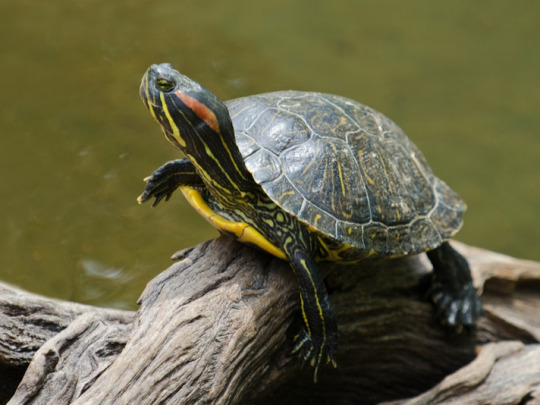
(Image: a red-eared slider basking on a log. It is a small turtle with a dark green upper shell striped with yellow and brown. Its body is a very dark green, almost black, with yellow stripes. A red stripe runs behind the eyes. End ID)
Trachemys scripta elegans is knows as the red-eared slider because of the red markings on the sides of its head and its ability to quickly slid into the water when threatened. They are freshwater turtles who reach an average of 15 - 20 cm (6-8 in) in carapace (upper shell) length, but can grow over 40 cm (16 in) in good conditions. The shell is composed of bony, keratinous scutes and varies in appearance as the turtle ages. The carapace starts out as a strong green color with variable markings and darkens to a brown color as the turtle ages. The plastron (lower shell) starts out yellow with darker markings and can darken to a red color with age. The turtle's skin is green with yellow stripes and also darkens with age. The shells and skin are always covered with stripes and irregular markings that help camouflage the animal by breaking up its silhouette. They have no external ear canals. Instead, the ear is covered with a disc of cartilage called the tympanum. During winter, they enter a state called brumantion, which is similar to hibernation but requires the turtle to occasionally wake up to eat and breathe.
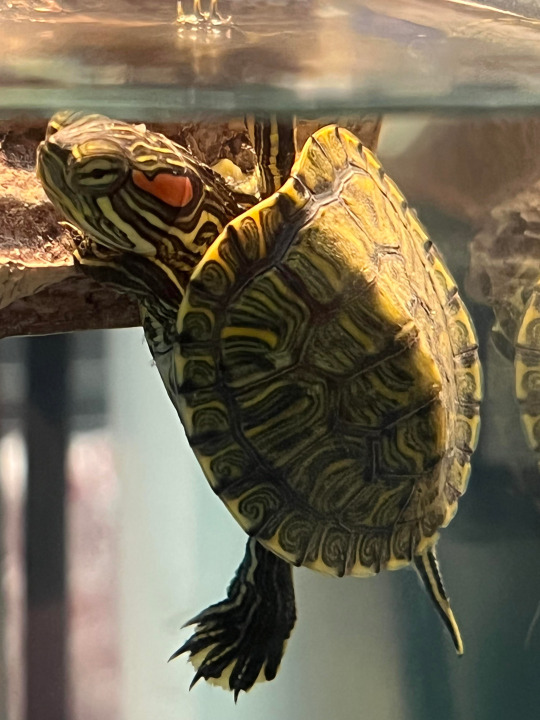
(Image: a juvenile red-eared slider in a tank. Its shell and skin are a lighter green and still heavily striped. The toes on one foot are spread, showing off the webbing between them. End ID)
It can be difficult to tell male and female red-eared sliders apart, especially when they are juveniles, but there are a few tells. Females usually get larger than males while the males have longer claws used to grab onto the female's shell while mating. Males also have a slightly concave plastron that helps them balance on the female's shell during mating. The biggest tell is the cloaca, which is located on the tail. In males, the cloaca opening is close to the tip of the tail, while in females it is close to the base.
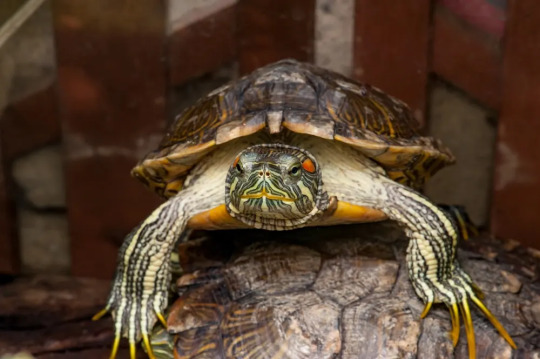
(Image: a red-eared slider seen from the front. It is identifiable as a male by its long claws. End ID)
Red-eared sliders are native to lakes, ponds, and slow-moving streams and rivers of the American midwest (which, for those of you who don't know, is on the east side of the country) and northern Mexico. They are omnivorous, feeding on aquatic and shore plants as well as aquatic invertebrates and small fish. They are not social, but tolerate each other's presence as long as there is enough food for everyone. In lean times, they will compete over food. Red-eared sliders are almost entirely aquatic, but they need to leave the water to warm their bodied by basking in the sun. Pond sliders can often be seen basking on rocks or logs sticking out of the water. They will bask in groups and even climb on top of each other. When they see danger, they will retreat into the water.
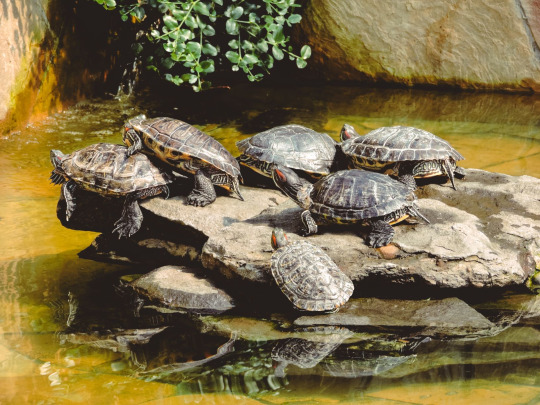
(image: a group of 6 red-eared sliders basking on a rock. One of them has partially climbed on top of another. End ID)
Mating season begin in spring and lasts until summer. Males will perform a courtship dance for females. He swims around the female while touching her head with the backs of his claws. This may help direct pheromones toward her. If the female approves, she will sink to the bottom and become receptive to mating. Otherwise, she will chase the male away. Courtship can take almost an hour, but the mating itself is short, lasting no more than 10 minutes. The time between fertilization and egg-laying can vary and females can hold onto sperm to fertilize herself later. Before laying eggs, females often have a change of diet and will spend extra time basking. The female will also spend more time on land, looking for a good spot to build a nest. The nest is a shallow pit dug in sand or loose soil. The female will lay between 2 and 30 eggs in the nest and bury them before leaving. A female can lay up to 5 clutches in a year. Incubation takes between 60 and 112 days. The temperature of the nest determines the sex of the hatchlings, with warmer soil producing females. The hatchlings use an egg tooth to break out of the egg, which will fall off a few hours after birth. Hatchlings are born with an external yolk sac attached to the bottom of the plastron that will provide nutrition for days after birth. The yolk sac being damaged or jostled enough to introduce air is fatal. The juvenile turtle needs to fully absorb the yolk sac and allow its plastron to fully fuse before entering the water, which takes about 21 days. Juveniles born late enough in the year may brumate in the nest and not emerge until next spring. Red-eared sliders reach sexual maturity at about 5 years of age and a turtle that survives its two years can live up to 30 or 40 years. Red-eared sliders can hybridize with the other pond slider subspecies.
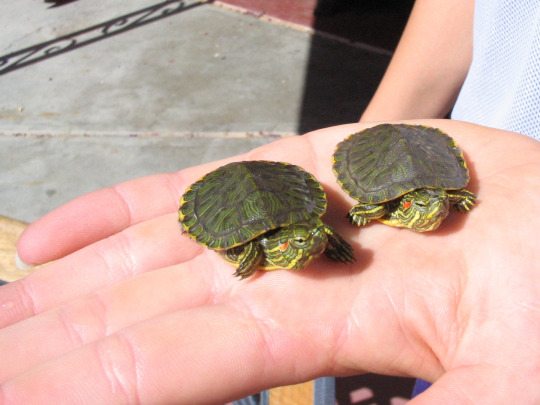
(Image: a pair of juvenile red-eared sliders being held in someone's hand. They are small enough that both together don't take up the full palm. End ID)
Red-eared sliders are classified as least concern by the IUCN, meaning they are not at risk of extinction. They have become popular pets due to being cheap with low maintenance costs and not getting too big. They are the world's most commonly traded reptile thanks to the pet trade, though they are also eaten by some people. Release or escape of pet red-eared sliders had led to them becoming an invasive species in many parts of the world as their fast maturation allows them to outcompete local species. They have also been responsible for spreading diseases and parasites to native turtle populations. Red-eared sliders are also asymptomatic carriers of salmonella and need to be handled with caution. I leave you with a fun fact: the Teenage Mutant Ninja Turtles are, in at least one continuity, red-eared sliders
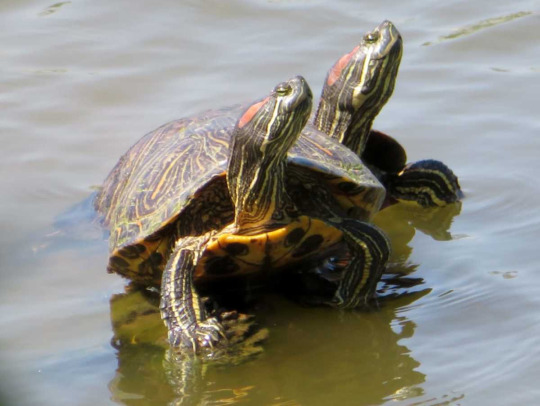
(Image: a pair of red-eared sliders standing in shallow water. their necks are extended and they are looking upwards. End ID)
#wet beast wednesday#red eared slider#pond slider#turtle#turtles#reptile#herpetology#freshwater ecology#ecology#biology#zoology#animal facts#informative#educational#image described
62 notes
·
View notes
Text

Another batch! they ended up eating the first clutch a few hours after I made the post- maybe they'll do better this round!
150 notes
·
View notes
Photo
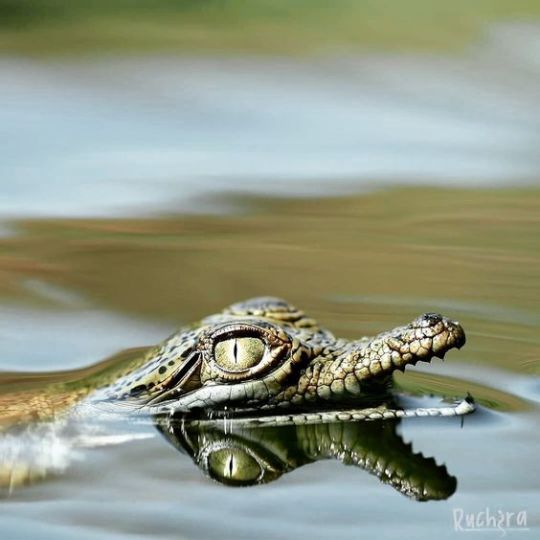
Baby Australian freshwater crocodile (Crocodylus johnstoni)
📸@rusomaweera
0 notes